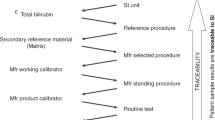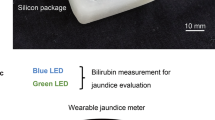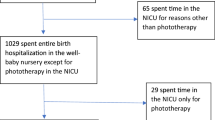Abstract
Severe neonatal hyperbilirubinemia (SNH) is a serious condition that occurs worldwide. Timely recognition with bilirubin determination is key in the management of SNH. Visual assessment of jaundice is unreliable. Fortunately, transcutaneous bilirubin measurement for screening newborn infants is routinely available in many hospitals and outpatient settings. Despite a few limitations, the use of transcutaneous devices facilitates early recognition and appropriate management of neonatal jaundice. Unfortunately, however, advanced and often costly screening modalities are not accessible to everyone, while there is an urgent need for inexpensive yet accurate instruments to assess total serum bilirubin (TSB). In the near future, novel icterometers, and in particular optical bilirubin estimates obtained with a smartphone camera and processed with a smartphone application (app), seem promising methods for screening for SNH. If proven reliable, these methods may empower outpatient health workers as well as parents at home to detect jaundice using a simple portable device. Successful implementation of ubiquitous bilirubin screening may contribute substantially to the reduction of the worldwide burden of SNH. The benefits of non-invasive bilirubin screening notwithstanding, any bilirubin determination obtained through non-invasive screening must be confirmed by a diagnostic method before treatment.
Impact
-
Key message: Screening methods for neonatal hyperbilirubinemia facilitate early recognition and timely treatment of severe neonatal hyperbilirubinemia (SNH). Any bilirubin screening result obtained must be confirmed by a diagnostic method.
-
What does this article add to the existing literature? Data on optical bilirubin estimation are summarized. Niche research strategies for prevention of SNH are presented.
-
Impact: Transcutaneous screening for neonatal hyperbilirubinemia contributes to the prevention of SNH. A smartphone application with optical bilirubin estimation seems a promising low-cost screening method, especially in low-resource settings or at home.
Similar content being viewed by others
Log in or create a free account to read this content
Gain free access to this article, as well as selected content from this journal and more on nature.com
or
References
Bhutani, V. K. et al. Predischarge screening for severe neonatal hyperbilirubinemia identifies infants who need phototherapy. J. Pediatr. 162, 477–82.e1 (2013).
Bhutani, V. K. et al. Neonatal hyperbilirubinemia and Rhesus disease of the newborn: incidence and impairment estimates for 2010 at regional and global levels. Pediatr. Res. 74, 86–100 (2013).
Donneborg, M.L., Hansen, B.M., Vandborg, P.K., Rodrigo-Domingo, M., Ebbesen, F. Extreme neonatal hyperbilirubinemia and kernicterus spectrum disorder in Denmark during the years 2000–2015. J Perinatol. 40, 194–202 (2020).
Greco, C. et al. Neonatal jaundice in low- and middle-income countries: lessons and future directions from the 2015 Don Ostrow trieste yellow retreat. Neonatology 110, 172–80 (2016).
Bang, A. T., Bang, R. A., Baitule, S., Deshmukh, M. & Reddy, M. H. Burden of morbidities and the unmet need for health care in rural neonates – a prospective observational study in Gadchiroli, India. Indian Pediatr. 38, 952–65 (2001).
Ngashangva, L., Bachu, V. & Goswami, P. Development of new methods for determination of bilirubin. J. Pharm. Biomed. Anal. 162, 272–85 (2019).
Hansen, T. W. R. Pioneers in the scientific study of neonatal jaundice and kernicterus. Pediatrics 106, e15 (2000).
Kramer, L. I. Advancement of dermal Icterus in the jaundiced newborn. Am. J. Dis. Child 118, 454–8 (1969).
Davidson, L. T., Merritt, K. K. & Weech, A. A. Hyperbilirubinemia in the newborn. Am. J. Dis. Child 61, 958–80 (1941).
Moyer, V. A., Ahn, C. & Sneed, S. Accuracy of clinical judgment in neonatal jaundice. Arch. Pediatr. Adolesc. Med 154, 391–4 (2000).
Riskin, A., Tamir, A., Kugelman, A., Hemo, M. & Bader, D. Is visual assessment of jaundice reliable as a screening tool to detect SNH? J. Pediatr. 152, 782–7, e1–2 (2008).
Keren, R., Tremont, K., Luan, X. & Cnaan, A. Visual assessment of jaundice in term and late preterm infants. Arch. Dis. Child Fetal Neonatal Ed. 94, F317–22 (2009).
Allen, F. H. Jr Early jaundice in the newborn; aids to detection. N. Engl. J. Med 258, 1302–3 (1958).
Gosset, I. H. A perspex icterometer for neonates. Lancet 1, 87–88 (1960).
Schumacher, R. E., Thornbery, J. M. & Gutcher, G. R. Transcutaneous bilirubinometry: a comparison of old and new methods. Pediatrics 76, 10–4 (1985).
Bilgen, H., Ince, Z., Ozek, E., Bekiroglu, N. & Ors, R. Transcutaneous measurement of hyperbilirubinaemia: comparison of the Minolta jaundice meter and the Ingram icterometer. Ann. Trop. Paediatr. 18, 325–8 (1998).
NICE National Institute for Health and Care Excellence. Neonatal jaundice 2010. https://www.nice.org.uk/guidance/cg98/evidence/full-guideline-245411821.
Olusanya, B. O., Slusher, T. M., Imosemi, D. O. & Emokpae, A. A. Maternal detection of neonatal jaundice during birth hospitalization using a novel two-color icterometer. PLoS ONE 12, e0183882 (2017).
Lee, A. C. et al. A novel icterometer for hyperbilirubinemia screening in low-resource settings. Pediatrics 143, e20182039 (2019).
Hannemann, R. E., DeWitt, D. P. & Wiechel, J. F. Neonatal serum bilirubin from skin reflectance. Pediatr. Res 12, 207–10 (1978).
Peevy, K. H. et al. Estimation of serum bilirubin by spectral reflectance of the skin, Duke University Medical Center. Pediatr. Res 12, 532 (1978).
Yamanouchi, I., Yamauchi, Y. & Igarashi, I. Transcutaneous bilirubinometry: preliminary studies of noninvasive transcutaneous bilirubin meter in the Okayama National Hospital. Pediatrics 65, 195–202 (1980).
https://www.draeger.com/en_me/Hospital/Products/Thermoregulation-and-Jaundice-Management/Jaundice-Management-and-Phototherapy/Jaundice-Screening/Jaundice-Meter-JM-105#instructions_for_use Last accessed at May 23rd, 2020.
https://philipsproductcontent.blob.core.windows.net/assets/20170616/f722df04b6ce4e7dad79a7940147347a.pdf Last accessed on May 23rd, 2020.
Subcommittee on Hyperbilirubinemia. Management of hyperbilirubinemia in the newborn infant 35 or more weeks of gestation. Pediatrics 114, 297–316 (2004).
Van den Esker-Jonker, B., Den Boer, L., Pepping, R. M. C. & Bekhof, J. Transcutaneous bilirubinometry in jaundiced neonates: a randomized controlled trial. Pediatrics 138, e20162414 (2016).
Chokemungmeepisarn, P., Tantiprabha, W., Kosarat, S. & Manopunya, S. Accuracy of the BilicareTM transcutaneous bilirubinometer as the predischarge screening tool for significant hyperbilirubinemia in healthy term and late preterm neonates. J. Matern Fetal Neonatal Med 33, 57–61 (2020).
Cucuy, M., Juster-Reicher, A., Flidel, O. & Shinwell, E. Correlation between transcutaneous and serum bilirubin in preterm infants before, during, and after phototherapy. J. Matern. Fetal Neonatal. Med. 31, 1323–6 (2018).
Arman, D., Topcuoğlu, S., Gürsoy, T., Ovalı, F. & Karatekin, G. The accuracy of transcutaneous bilirubinometry in preterm infants. J. Perinatol. 40, 212–8 (2020).
Nahar, N. et al. Comparison of Serum Bilirubin with Transcutaneous Bilirubinometry in Late Preterm and Term Newborn. Mymensingh Med. J. 26, 621–7 (2017).
Johnson, S. M. et al. Validation of transcutaneous bilirubinometry during phototherapy for detection and monitoring of neonatal jaundice in a low-income setting. Paediatr. Int. Child Health 40, 25–29 (2020).
Aranda Cazón, C., Torrubia Doredo, B., Álvarez López, C., De Gracia Hils, Y. & Cuadrado Cenzual, M. C. Determining the correlation and accuracy of three methods of measuring neonatal bilirubin concentration: serum, capillary and transcutaneous bilirubin. Biomed. J. Sci. Tech. Res. 1, 722–6 (2017).
Grohmann, K. et al. Bilirubin measurement for neonates: comparison of 9 frequently used methods. Pediatrics 117, 1174–83 (2006).
Hemmati, F. & Rad, N. A. K. The value of Bilicheck® as a screening tool for neonatal jaundice in the South of Iran. Iran. J. Med Sci. 38, 122–8 (2013).
Mussavi, M., Niknafs, P. & Bijari, B. Determining the correlation and accuracy of three methods of measuring neonatal bilirubin concentration. Iran. J. Pediatr. 23, 333–9 (2013).
Ozkan, H., Oren, H., Duman, N. & Duman, M. Dermal bilirubin kinetics during phototherapy in term neonates. Acta Paediatr. 92, 577–81 (2003).
Starowicz, O., Edwards, P., Schmidt, P. & Birch, P. Evaluation of the Kejian KJ-8000 bilirubinometer in an Australian setting. J. Paediatr. Child Health 56, 283–8 (2020).
Hulzebos, C. V., Vader-van Imhoff, D. E., Bos, A. F. & Dijk, P. H. Should transcutaneous bilirubin be measured in preterm infants receiving phototherapy? The relationship between transcutaneous and total serum bilirubin in preterm infants with and without phototherapy. PLoS ONE 14, e0218131 (2019).
Neocleous, C. et al. A comparison between transcutaneous and total serum bilirubin in healthy-term Greek neonates with clinical jaundice. Prague Med. Rep. 115, 33–42 (2014).
Taylor, J. A. et al. Discrepancies between transcutaneous and serum bilirubin measurements. Pediatrics 135, 224–31 (2015).
Olusanya, B. O. & Emokpae, A. A. Use of transcutaneous bilirubin to determine the need for phototherapy in resource-limited settings. Neonatology 111, 324–30 (2017).
Maisels, M. J. Transcutaneous bilirubin measurement: does it work in the real world? Pediatrics 135, 364–6 (2015).
Rodríguez-Capote, K., Kim, K., Paes, B., Turner, D. & Grey, V. Clinical implication of the difference between transcutaneous bilirubinometry and total serum bilirubin for the classification of newborns at risk of hyperbilirubinemia. Clin. Biochem. 42, 176–9 (2009).
Maisels, M. J., Bhutani, V. K., Bogen, D., Newman, T. B., Stark, A. R. & Watchko, J. F. Hyperbilirubinemia in the newborn infant > or = 35 weeks’ gestation: an update with clarifications. Pediatrics 124, 1193–8 (2009).
Maisels, M. J., Coffey, M. P. & Kring, E. Transcutaneous bilirubin levels in newborns <35 weeks’ gestation. J. Perinatol. 35, 739–44 (2015).
Nagar, G., Vandermeer, B., Campbell, S. & Kumar, M. Reliability of transcutaneous bilirubin devices in preterm infants: a systematic review. Pediatrics 132, 871–81 (2013).
Briscoe, L., Clark, S. & Yoxall, C. W. Can transcutaneous bilirubinometry reduce the need for blood tests in jaundiced full term babies? Arch. Dis. Child Fetal Neonatal Ed. 86, F190–2 (2002).
De Luca, D., Jackson, G. L., Tridente, A., Carnielli, V. P. & Engle, W. D. Transcutaneous bilirubin nomograms: a systematic review of population differences and analysis of bilirubin kinetics. Arch. Pediatr. Adolesc. Med 163, 1054–9 (2009).
Yu, Z. B., Han, S. P. & Chen, C. Bilirubin nomograms for identification of neonatal hyperbilirubinemia in healthy term and late-preterm infants: a systematic review and meta-analysis. World J. Pediatr. 10, 211–8 (2014).
Bosschaart, N. et al. Limitations and opportunities of transcutaneous bilirubin measurements. Pediatrics 129, 689–94 (2012).
Baker, C., et al. BME 272 NCIIA Project Proposal Neonatal Jaundice. (2012).
Patel, P. ClikJaundice: using mobile technology to detect yellow in newborns. http://thealternative.in/social-business/clickjaundiceusing-the-phone-to-prevent-jaundice-in-newborns/. (2013).
De Greef, L., et al. BiliCam: using mobile phones to monitor newborn jaundice. In: Proceedings of the 2014 ACM International Joint Conference on Pervasive and Ubiquitous Computing (UbiComp ’14); 331–342 (Seattle, WA, 2014).
Leung, T. S. et al. Screening neonatal jaundice based on the sclera color of the eye using digital photography. Biomed. Opt. Express 6, 4529–38 (2015).
Rong, Z. H. et al. Evaluation of an automatic image-based screening technique for neonatal hyperbilirubinemia. Zhonghua Er Ke Za Zhi 54, 597–600 (2016).
Aydin, M., Hardalac, F., Ural, B. & Karap, S. Neonatal jaundice detection system. J. Med. Syst. 40, 166 (2016).
Swarna, S., Pasupathy, S., Chinnasami, B., Manasa, D. N. & Ramraj, B. The smart phone study: assessing the reliability and accuracy of neonatal jaundice measurement using smart phone application. Int. J. Contemp. Pediatr. 5, 285–9 (2017).
Taylor, J. A. et al. Use of a smartphone app to assess neonatal jaundice. Pediatrics 140, e20170312 (2017).
Munkholm, S. B., Krøgholt, T., Ebbesen, F., Szecsi, P. B. & Kristensen, S. R. The smartphone camera as a potential method for transcutaneous bilirubin measurement. PLoS ONE 13, e0197938 (2018).
Leartveravat, S. Transcutaneous bilirubin measurement in full term neonate by digital camera. Med J Srisaket Surin Buriram Hospit. 24, 108–18 (2009).
Sufian, A. T., Jones, G. R., Shabeer, H. M., Elzagzoug, E. Y. & Spencer, J. W. Chromatic techniques for in vivo monitoring jaundice in neonate tissues. Physiol. Meas. 39, 095004 (2018).
Rizvi, M. R., Alaskar, F. M., Albaradie, R. S., Rizvi, N. F. & Al-Abdulwahab, K. A novel non-invasive technique of measuring bilirubin levels using BiliCapture. Oman Med J. 34, 26–33 (2019).
Leung, T. S., Outlaw, F., MacDonald, L. W. & Meek, J. Jaundice Eye Color Index (JECI): quantifying the yellowness of the sclera in jaundiced neonates with digital photography. Biomed. Opt. Express 10, 1250–6 (2019).
Padidar, P. et al. Detection of neonatal jaundice by using an android OS-based smartphone application. Iran. J. Pediatr. 29, e84397 (2019).
Outlaw, F. et al. Smartphone screening for neonatal jaundice via ambient-subtracted sclera chromaticity. PLoS ONE 15, e0216970 (2020).
Aune, A., Vartdal, G., Bergseng, H., Randeberg, L. L. & Darj, E. Bilirubin estimates from smartphone images of newborn infants’ skin correlated highly to serum bilirubin levels. Acta Paediatr. 1–7 (2020).
Watchko, J. F. Maternal instruction on neonatal jaundice: what can we learn from the Stop Kernicterus in Nigeria (SKIN) experience? J. Pediatr. 221, 7–8 (2020).
Wennberg, R. P. et al. Maternal instruction about jaundice and the incidence of acute bilirubin encephalopathy in Nigeria. J. Pediatr. 221, 47–54 (2020).
Inamori, G. et al. Neonatal wearable device for colorimetry-based real-time detection of jaundice with simultaneous sensing of vitals. Sci. Adv. 7, eabe3793 (2021).
Acknowledgements
We greatly appreciate the help of T. van Wulfften Palthe in correcting the English grammar and language. The study was supported by grants NV18-07-00342 and RVO-VFN64165/2020 from the Czech Ministry of Health. The support of an intramural grant of Fondazione Italiana Fegato to Claudio Tiribelli is appreciated.
Author information
Authors and Affiliations
Contributions
Study concept and design, and retrieving and analyzing the literature: C.V.H., L.V., C.D.C.Z., C.C. and C.T. Drafting, and critical revision of the manuscript for important intellectual content: C.V.H., L.V., C.D.C.Z., A.D., P.S., E.A.E.H., C.C. and C.T. All authors approved the final manuscript as submitted
Corresponding author
Ethics declarations
Competing interests
C.T. is the President and C.D.C.Z. is the CTO of Bilimetrix, the company responsible for the development of the Bilistick® System. The remaining authors declare no competing interests.
Patient consent
Not required
Additional information
Publisher’s note Springer Nature remains neutral with regard to jurisdictional claims in published maps and institutional affiliations.
Rights and permissions
About this article
Cite this article
Hulzebos, C.V., Vitek, L., Coda Zabetta, C.D. et al. Screening methods for neonatal hyperbilirubinemia: benefits, limitations, requirements, and novel developments. Pediatr Res 90, 272–276 (2021). https://doi.org/10.1038/s41390-021-01543-1
Received:
Revised:
Accepted:
Published:
Issue date:
DOI: https://doi.org/10.1038/s41390-021-01543-1
This article is cited by
-
Performance of smartphone application to accurately quantify hyperbilirubinemia in neonates: a systematic review with meta-analysis
European Journal of Pediatrics (2023)
-
5 Tage altes Neugeborenes mit „Gelbsucht“
Monatsschrift Kinderheilkunde (2022)



